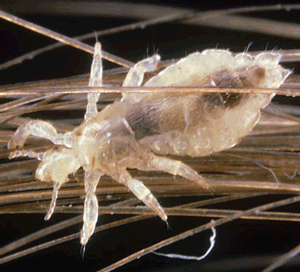Basic Features of a louse or commonly known as lice

- They are ectoparasitic insects that thrive in human hair, they are usually found on the scalp.
- They cannot fly, lice gets around with its six legs instead.
- Lice grow to 1/8 inch while nymphs that are grey grow to 1/16 inch, same size as a sesame seed. It is tan colored.
- Their legs are adapted with claws to grasp hair on human scalp. The head is flattened which makes it almost impossible for one to feel it on the hair and its mouth part equipped with a proboscis allows it to pierce and suck human blood.
- Lice eggs are found to be yellow, brown, translucent or white. They measure 1/16 inch.
- Louse is not an animal parasite.
How an infestation begins on human Hair
Lice species found on human hair cannot fly so it attaches to a host through physical contact with the family members or from an infested child at a playground to another. Sharing hairbrush with a lice infested person can cause the parasite to attach to a new host. Contrary to popular opinion, lice is not attracted to just dirty hair, it can happen to anyone. However, keeping good hair hygiene will remove them.
Can lice transmit diseases?
Head lice are uncomfortable and irritating but they cannot spread or transmit diseases from one person to another. The bites are itchy and if scratched can result to the formation of open sores. These sores, if left untreated can develop other infections caused by the activities of a harmful bacteria festering on it.
Symptoms and signs of an infestation
A juvenile or adult louse infestation is noticed when the patient begins to scratch uncontrollably and frequently. You may notice sores and wounds on the head.
How to remove head lice
There are steps you can take in order to be sure that fleas never come around your family or spread. Special lice combs that are purchased over the counter or on prescription are used to remove the parasites. You should machine wash every clothing and bedding under hot water with a mixture of lemon. Then after washing, transfer immediately to a better dryer. Then, contact your local pest control expert to tell you the best methods to apply and how to manage the situation. If the bites develop complications after treatment, contact your doctor.
Fleas
Fleas are also ectoparasites, but unlike head lice, they are not picky eaters which make them very dangerous to you and your beloved pet. It is essential that you learn everything there is to know about the tiny blood sucking insects in order to effectively fight and control fleas.
The two parasites can live on you and cause discomfort to everyone in your family. They both bite and each bite is itch and irritating. Outside these, they have little else in common. Fleas can jump long distance, at least seven inches into the air, while lice can barely cross a room. They are painfully slow. Fleas are therefore more difficult to remove from the home than lice, in fact the entire process is frustrating especially when you decide not to engage the services of a pest expert. This is why administering preventatives such as Vectra 3D is crucial.
Can pets spread lice and fleas?
Fleas are not picky although most species would rather feed on cats and dogs, they will jump on any mammal available to survive. This is why, if your pet is infested with fleas, you may notice similar bite marks on your skin. However, head lice are very restrictive, host wise. Louse will not move from pet to children or from children to pets.
Pets and lice infestations
It is a fact that head lice on humans are not as a result of bad hygiene, but same is not applicable to animals like dogs and cats. They get infested with lice as a result of poor or non-existent hygiene. Puppies and kittens are more susceptible to lice, particular kittens as is noticed in kitty mills.
There are two species of lice that generally attack dogs, they are sucking lice and biting lice. Another variety of these biting lice infests cats too. Dogs and cats that are affected will constantly scratch due to the itches caused by lice bites.
On the bright side, louse is easy to get rid of and treat on a pet. All you have to do is find out from your veterinarian the best product you can apply. Most will recommend shampoos and insecticide powders like pyrethrin. Never administer human treatments for lice on your pet, it will not be effective. You can treat further with frontline if your vet recommends it.
All these are topical treatments, next apply preventatives to remove lice eggs and prevent them from coming back. Clean everything you suspect your pet has come in contact with then machine-wash its bedding. Remember to sterilize any grooming equipment you use on your cat.
Your pet and Fleas
If your pet never goes outside, you may drastically reduce the chances of the pet getting infested. However, fleas can be indoors too especially if the house is overrun with rodents that are infested. Getting rid of fleas is a problem, you can treat with spot on medications, oral medications and pet specific shampoos. Then vacuum your house thoroughly at least five times a week and apply an insecticide. If it has spread, then you may need the services of a pest control expert or a good flea repellent.
Prevention
None of the pets deserve to be infested with any of these parasites, even if lice is easy to remove they can make animals very miserable. The only thing you can do is to administer preventatives such as advantix, K9 advantix, Advantage II or frontline plus once each month.